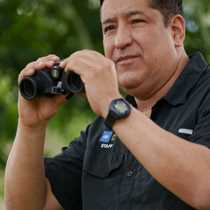Belluda Caño & El Dorado River
This expedition has been extraordinarily good for wildlife sightings. Early in the morning while exploring “Belluda Caño,” we had one of the rarest sightings in the Amazon rain forest. Several lucky guests spotted a Harpy Eagle (Harpia harpyja)! from one of the skiffs while watching a troop of Saddle backed Tamarin monkeys. It seemed that this powerful predator was trying to capture one of the monkeys. The harpy eagle is by far the largest and bulkiest eagle in South America. It has a heavy bill and thick legs and toes. It measures in length an average of 35-40 inches and its wingspan is the range of 69-79 inches! This bird species is a very powerful one and it is considered a precious and rare sighting for any given ornithologist or bird enthusiast all over the world. It was seen perching on top a high tree for just a couple of minutes before flying away. The big surprise was that we saw a second harpy eagle from a different skiff. This time this majestic eagle was seen flying very high up in the sky. One of our guests, who has one of the most powerful telephoto lenses had some photographs that serve as memories of this unusual sighting.
Another remarkable sighting was a Night or Owl monkey (Aotus vociferans). This rather uncommonly seen animal is the only monkey species in South America with huge eyes and nocturnal activity. Night monkeys live in small family groups of two to five individuals, feed on fruit, insects, and flower nectar and are relatively sedentary. By day they sleep mainly in in tree hollows where they can be seen spending long hours just sitting quietly.
Another great sighting was a couple of Yellow-throated Woodpeckers (Piculus flavigula) that were seen very busy working in making a hole while lighted with a beautiful light that allowed our guests us to take great photographs of these birds in action.
The rest of the morning was devoted to a couple of presentations. One of our Delfin II naturalists, Jesus Mesia, who is a Bora native talked to us about his fascinating life when growing up in the rain forest. He shared with us anecdotes, legends, and insights of his life. Naturalist Juan Luis Ihuaraqui gave us an overview of what we have already seen in the expedition. Juan Luis made a review of our wildlife checklist.
The late afternoon was spent exploring “El Dorado” River. We saw several bird species; a female Brown-three toed Sloth with her baby and enjoyed the late sounds of the forest at sunset. On the way back and with the aid of powerful spotlights we came back covered with the night. We spotted some juvenile caiman alligators and a couple of nocturnal bird species: the Great Potoo (Nyctibius grandis) and the Common Pauraque (Nyctidromus albicollis).
It is quite late at night at the moment I am writing these paragraphs, but I can still feel the adrenaline being pumped through my veins remembering all the great sightings we had today.




